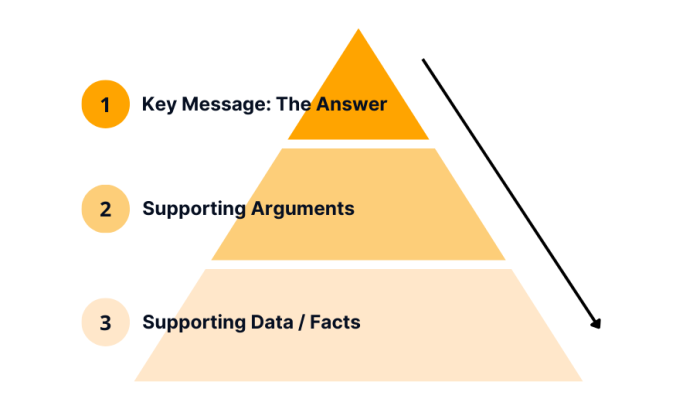The Pyramid Principle, created by Barbara Minto, an ex-McKinsey consultant, improves clarity and impact in communication. This principle is the basis of most management consulting communication and is especially useful for making decisions and solving problems. By organizing ideas logically and hierarchically, it helps the audience easily understand and remember key messages and recommendations.
The Concept of the Pyramid Principle
The Pyramid Principle is about structuring information in a top-down approach. The main message or conclusion is presented first, followed by supporting arguments, data and facts. This structure reflects a pyramid where the most important point is at the top and is supported by broader base layers of information. Use the pyramid structure to provide summaries or recommendations at the end or in between your case interviews.
The Pyramid Principle consists of three parts:

1. Key Message: The Answer
First, present your key message or conclusion to the interviewer. This approach immediately grabs the attention and provides a clear direction for the information that follows. It should be clear, logical and effective.
2. Supporting Arguments
This level contains the main arguments or ideas that support the key message. You sound more structured and prepared when you focus on three main arguments directly below the key message. Group and summarize them logically. Each group should relate directly to the recommendation.
3. Supporting Data and Facts
Once you have made your point, you can move on to the next level and start sharing the work behind your conclusion. This level contains more detailed information, data and facts to support the key message of the first level. Each main point is broken down into more specific sub-points here.
Benefits of the Principle
This Framework offers several key benefits for structuring communication effectively:
- Clarity: The pyramid principle ensures that the audience understands the essentials right from the start by anticipating the main message. This reduces ambiguity and improves understanding.
- Focus: The hierarchical structure keeps the communication focused on the most important information, avoiding unnecessary details that can distract the interviewer.
- Efficiency: The logical flow and clear organization of the ideas save time for both the speaker and the interviewer. They make it possible to quickly identify the most important points and the arguments that support them.
- Persuasiveness: A well-structured argument is more convincing. The pyramid principle strengthens the overall persuasiveness of communication by organizing supporting points logically.
Practical Example
Scenario: A company is considering entering a new market.
1. Key Message:
Entering the new market is feasible and strategically beneficial.
2. Supporting Arguments:
- Market Potential: The market is large and has a high growth rate.
- Competitive Landscape: Few strong competitors, with room for differentiation.
- Financial Profitability: Projected revenues exceed costs, break-even point will be reached within two years.
3. Supporting Data and Facts:
Market Potential:
- The market size is estimated at 1 billion dollars with an annual growth rate of 10%.
- Key customer segments include young professionals and tech-affine consumers.
Competitive Landscape:
- Key competitors have a 60% market share, leaving 40% for new entrants.
- Our unique value proposition can fill gaps not covered by the competition.
Financial Profitability:
- The initial investment cost is $10 million, with projected annual sales of $15 million.
- The break-even analysis shows profitability within two years with a positive Net Present Value (NPV).
By structuring the information according to the Pyramid Principle, you can present the interviewer with clear, logical and convincing arguments for market entry, ensuring that listeners quickly grasp the main message and supporting details.
Key Takeaways - How to Communicate Effectively
- Structure the case conclusion recipient-friendly by applying the Pyramid Principle.
- Start with the main message, organize supporting points into logical groups and ensure a smooth flow of information, which increases the effectiveness of business communication.



